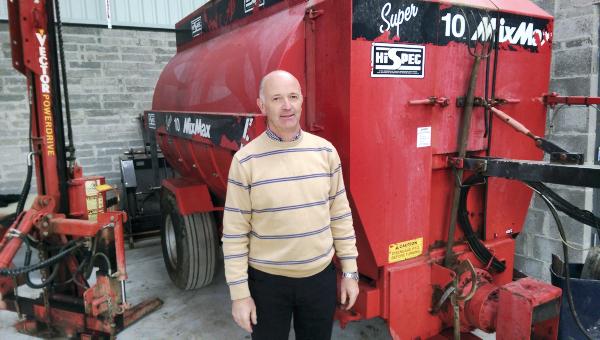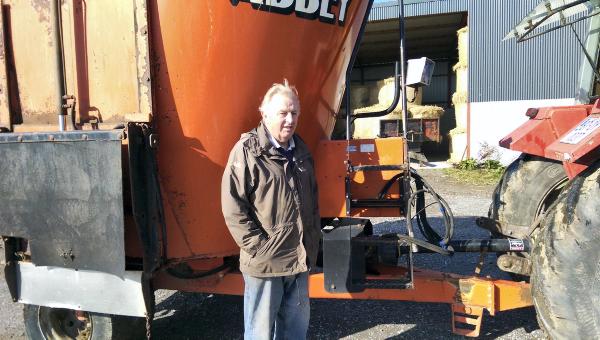Most farmers, when the sums are finished, often wonder could I have made more. Unfortunately, we are at the mercy of the market for our produce, but we can analyse the efficiency in operating feeding machinery during the year.
The diet feeder, like any other input, has advantages and disadvantages associated with it. As with any other investment or input decision, costs and benefits should determine whether its use is viable on a particular farm.
This calculation is often complex for two main reasons:
Machine costs are always difficult to calculate.Benefits, such as less manual labour, improved feeding management, the ability to use mixed forage diets etc, are difficult to value.The concept of complete diet feeding (also known as total mixed ration feeding) has been around for some time. Complete diet feeding (or TMR) requires a mixer wagon to mix and distribute the feed components immediately prior to feeding. The problem is that often these machines are not being used to their full potential, and are just an expensive wheelbarrow for silage.
There is also the possibility that the diet feeder will offer a solution for farmers who are tight on land to increase their herd size by allowing them to buffer-feed on the farm.
This autumn, I got the chance to visit three farms that have been using a diet feed for a number of years. The purpose of the exercise was to find out if these farmers were happy with their investment, and would they reinvest in a new diet feeder again. It was very interesting to learn about their feeding programme, and some tips they have on the farms.
Bertie Williams is a suckler farmer from outside Tullamore. Bertie’s farming system is broken in to a spring and autumn-calving herd, and also growing winter and spring barley to be rolled and fed on-farm.
All the animals are finished on the farm on a two-year calf-to-beef system. There are 250 animals on the farm, with 80 cattle finished each year.
In 2005 Bertie took the plunge and invested in an Abbey tub feeder. Bertie said: “I should have had one 20 years earlier.” He is delighted at how reliable the machine is and how much the labour has reduced. “Carrying buckets is a thing of the past on this farm.”
The farmer grows 28ha of silage every year, with 200 bales taken off strong paddocks also. The 16ha of cereals grown roughly gives 125t of rolled barley every year. The only feed bought in is 16t of soya and some balancer ration in the spring.
The feeding operation is all done using the tub feeder. The farm has two tractors, with a loader on the newest. Silage is mixed with rolled barley and straw as required during the year. Barley is rolled on-farm, giving an output of 3t per hour. All the rolled barley is carried by an augur to an enclosed section of the shed. The rolled grain is easily collected with the loader and added the feeder.
Andrew Moloney from Edenderry, Co Offaly, has an autumn and spring-calving herd. Andrew has mostly pit silage, with some baled silage. Andrew said: “Using bales in the feeder is not as quick as you need to give the feeder more time.” The yard is extremely well laid out, with good passages to travel.
The feeder Andrew uses is a Keenan 140 with a bale handler. This machine was purchased secondhand in 2008 for €15,000. The farm incorporates rolled barley with silage and some ration as required.
Andrew finds the diet feeder has pluses and minuses. The good point is that he can mix in grain and straw with silage. But the bad points for him come in the spring, when slurry has to be spread. The tractors are tied up feeding, so he has to feed all the animals in the morning. He then has to take off the diet feeder and put on the tanker, and the agitator. This is very time-consuming at this time of year for Andrew.
He finds that the diet feeder is seldom full, as he has different stock to feed requiring other mixes and amounts. Sometimes he feels the loader and grab might be quicker for the smaller amounts of feed.
John Delaney, a machinery technician working with Teagasc in Ballyhaise College, explained they cannot manage without the feeder. “The college farm is just too spread out over a large area with different units,” said John.
The last model purchased in 2009 was a Hi Spec 10m3 paddle feeder. They are restricted to this size and height because some of the sheds are low.
John praised the reliability of the machine, although it is essentially always feeding silage, around 2,000t every year, and some straw. There is no real pressure on the feeder to chop any material. The original knives are still being used, but some rubbers on the paddles need to be replaced soon. The unloading conveyor chain and belt is the only replacement part purchased since 2009. There is no real pressure on the feeder to chop any material.
To give an idea of the workload on the college farm, they have a 120-cow dairy herd, 50-cow suckler herd, 200-ewe sheep flock, and 200 cattle of various types, with 100 finished every year.
In Ballyhaise College all the stock on the farm is normally housed for six months. To get around to all sheds and complete feeding, the tractor and feeder runs for four hours each day during this time, according to John. This means the tractor and feeder will put up 728 hours of work over the winter months on operating the diet feeder alone.
We need to analyse what this system is costing to run. The big problem is depreciation – diet feeders lose a lot of money in a short space of time. It might benefit some farmers to have a capital allowance for tax purposes.
The costs are based on the farmers’ own figures for repairs and maintenance. This was then spread over the total number of years the diet feed has worked on the farm and the average number of animals each year.
The diesel figures were estimated by the number of hours worked using the diet feeder each day. The calculation was based on the efficiency rating for each tractor in litres per hour. The price of the diesel was standardised at 87 cent including VAT for all farms to give uniform figures.
The breakdown of costs does not include fixed costs such as road tax, tractor insurance, and labour. If the tractor cost was exclusive to the feeder, this additional cost could be allocated as fixed cost against the mechanised feeding operation.
Table 1 shows that diesel is the main cost. This does not include the loading tractor. Teagasc Ballyhaise had the highest diesel costs due to the fragmented nature of the college farmyard, which is broken into three areas. That is more time taken to get around burning more fuel.
Andrew Moloney is feeding 30 more animals a day but can complete the task in three hours versus four hours in Ballyhaise.
The obvious choice to reduce travelling in the yard would be to use a bigger diet feeder, reducing the time requirement. But in many cases such as Ballyhaise College some sheds are restrictive to bigger machines.
Another factor that will affect performance is the number of different feed lots with different mix requirements for every group of animal.
The next scenario to examine is if the three farms above renew their diet feeder, and look at how the extra repayments will affect the cost per animal annually. The cost of renewing the diet feeder will be taken at €35,000 for each farm (see Table 2). The repayment will be divided over a five-year period at 0% interest for this example. As these farms have a second tractor and loader, we will not be adding in these costs.
The decision whether to renew a diet feeder on a farm is essentially down to the farmer. Two of the above farms said they would renew and one farmer would be 65% inclined to take another machine. One farmer said: “I would be dead again now if the diet feeder had not arrived.” For many, the ability to formulate cost-effective home rations by mixing keenly purchased straights in the diet feeder is the principal reason for investment.
The plus points of the machines are that they are extremely reliable; they can incorporate many feeds, and allow forage to be fed on outfarms. But diesel costs and depreciation are two considerations that must be taken in to account.
Most farmers, when the sums are finished, often wonder could I have made more. Unfortunately, we are at the mercy of the market for our produce, but we can analyse the efficiency in operating feeding machinery during the year.
The diet feeder, like any other input, has advantages and disadvantages associated with it. As with any other investment or input decision, costs and benefits should determine whether its use is viable on a particular farm.
This calculation is often complex for two main reasons:
Machine costs are always difficult to calculate.Benefits, such as less manual labour, improved feeding management, the ability to use mixed forage diets etc, are difficult to value.The concept of complete diet feeding (also known as total mixed ration feeding) has been around for some time. Complete diet feeding (or TMR) requires a mixer wagon to mix and distribute the feed components immediately prior to feeding. The problem is that often these machines are not being used to their full potential, and are just an expensive wheelbarrow for silage.
There is also the possibility that the diet feeder will offer a solution for farmers who are tight on land to increase their herd size by allowing them to buffer-feed on the farm.
This autumn, I got the chance to visit three farms that have been using a diet feed for a number of years. The purpose of the exercise was to find out if these farmers were happy with their investment, and would they reinvest in a new diet feeder again. It was very interesting to learn about their feeding programme, and some tips they have on the farms.
Bertie Williams is a suckler farmer from outside Tullamore. Bertie’s farming system is broken in to a spring and autumn-calving herd, and also growing winter and spring barley to be rolled and fed on-farm.
All the animals are finished on the farm on a two-year calf-to-beef system. There are 250 animals on the farm, with 80 cattle finished each year.
In 2005 Bertie took the plunge and invested in an Abbey tub feeder. Bertie said: “I should have had one 20 years earlier.” He is delighted at how reliable the machine is and how much the labour has reduced. “Carrying buckets is a thing of the past on this farm.”
The farmer grows 28ha of silage every year, with 200 bales taken off strong paddocks also. The 16ha of cereals grown roughly gives 125t of rolled barley every year. The only feed bought in is 16t of soya and some balancer ration in the spring.
The feeding operation is all done using the tub feeder. The farm has two tractors, with a loader on the newest. Silage is mixed with rolled barley and straw as required during the year. Barley is rolled on-farm, giving an output of 3t per hour. All the rolled barley is carried by an augur to an enclosed section of the shed. The rolled grain is easily collected with the loader and added the feeder.
Andrew Moloney from Edenderry, Co Offaly, has an autumn and spring-calving herd. Andrew has mostly pit silage, with some baled silage. Andrew said: “Using bales in the feeder is not as quick as you need to give the feeder more time.” The yard is extremely well laid out, with good passages to travel.
The feeder Andrew uses is a Keenan 140 with a bale handler. This machine was purchased secondhand in 2008 for €15,000. The farm incorporates rolled barley with silage and some ration as required.
Andrew finds the diet feeder has pluses and minuses. The good point is that he can mix in grain and straw with silage. But the bad points for him come in the spring, when slurry has to be spread. The tractors are tied up feeding, so he has to feed all the animals in the morning. He then has to take off the diet feeder and put on the tanker, and the agitator. This is very time-consuming at this time of year for Andrew.
He finds that the diet feeder is seldom full, as he has different stock to feed requiring other mixes and amounts. Sometimes he feels the loader and grab might be quicker for the smaller amounts of feed.
John Delaney, a machinery technician working with Teagasc in Ballyhaise College, explained they cannot manage without the feeder. “The college farm is just too spread out over a large area with different units,” said John.
The last model purchased in 2009 was a Hi Spec 10m3 paddle feeder. They are restricted to this size and height because some of the sheds are low.
John praised the reliability of the machine, although it is essentially always feeding silage, around 2,000t every year, and some straw. There is no real pressure on the feeder to chop any material. The original knives are still being used, but some rubbers on the paddles need to be replaced soon. The unloading conveyor chain and belt is the only replacement part purchased since 2009. There is no real pressure on the feeder to chop any material.
To give an idea of the workload on the college farm, they have a 120-cow dairy herd, 50-cow suckler herd, 200-ewe sheep flock, and 200 cattle of various types, with 100 finished every year.
In Ballyhaise College all the stock on the farm is normally housed for six months. To get around to all sheds and complete feeding, the tractor and feeder runs for four hours each day during this time, according to John. This means the tractor and feeder will put up 728 hours of work over the winter months on operating the diet feeder alone.
We need to analyse what this system is costing to run. The big problem is depreciation – diet feeders lose a lot of money in a short space of time. It might benefit some farmers to have a capital allowance for tax purposes.
The costs are based on the farmers’ own figures for repairs and maintenance. This was then spread over the total number of years the diet feed has worked on the farm and the average number of animals each year.
The diesel figures were estimated by the number of hours worked using the diet feeder each day. The calculation was based on the efficiency rating for each tractor in litres per hour. The price of the diesel was standardised at 87 cent including VAT for all farms to give uniform figures.
The breakdown of costs does not include fixed costs such as road tax, tractor insurance, and labour. If the tractor cost was exclusive to the feeder, this additional cost could be allocated as fixed cost against the mechanised feeding operation.
Table 1 shows that diesel is the main cost. This does not include the loading tractor. Teagasc Ballyhaise had the highest diesel costs due to the fragmented nature of the college farmyard, which is broken into three areas. That is more time taken to get around burning more fuel.
Andrew Moloney is feeding 30 more animals a day but can complete the task in three hours versus four hours in Ballyhaise.
The obvious choice to reduce travelling in the yard would be to use a bigger diet feeder, reducing the time requirement. But in many cases such as Ballyhaise College some sheds are restrictive to bigger machines.
Another factor that will affect performance is the number of different feed lots with different mix requirements for every group of animal.
The next scenario to examine is if the three farms above renew their diet feeder, and look at how the extra repayments will affect the cost per animal annually. The cost of renewing the diet feeder will be taken at €35,000 for each farm (see Table 2). The repayment will be divided over a five-year period at 0% interest for this example. As these farms have a second tractor and loader, we will not be adding in these costs.
The decision whether to renew a diet feeder on a farm is essentially down to the farmer. Two of the above farms said they would renew and one farmer would be 65% inclined to take another machine. One farmer said: “I would be dead again now if the diet feeder had not arrived.” For many, the ability to formulate cost-effective home rations by mixing keenly purchased straights in the diet feeder is the principal reason for investment.
The plus points of the machines are that they are extremely reliable; they can incorporate many feeds, and allow forage to be fed on outfarms. But diesel costs and depreciation are two considerations that must be taken in to account.






 This is a subscriber-only article
This is a subscriber-only article












SHARING OPTIONS: